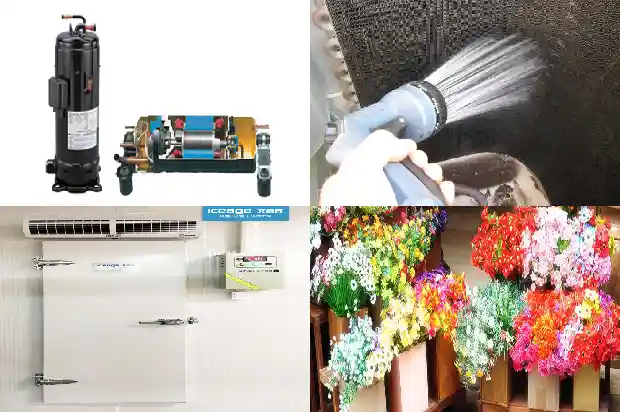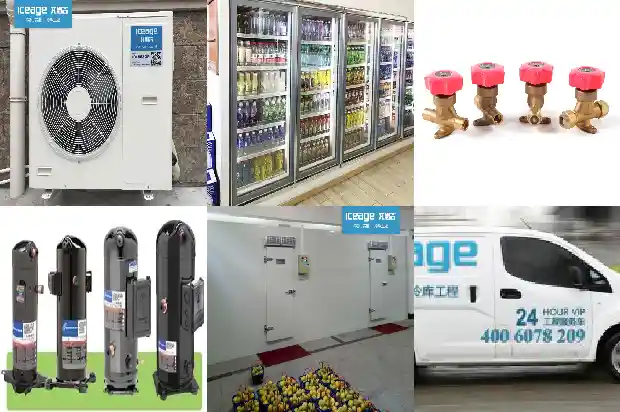Why Does the Air Cooler Frost? What Are the Defrosting Methods?
2025-03-09
As an important component of the cold storage refrigeration system, when the air cooler operates at a temperature lower than 0°C and lower than the dew point of the air, frost begins to form on the surface of the evaporator. As the operation time increases, the frost layer will become thicker and thicker.
A thicker frost layer will lead to two main problems:
One is the increase in the thermal resistance of heat transfer. The cold energy inside the evaporator coil cannot effectively pass through the pipe wall and the frost layer to be transferred into the cold storage.
The other problem:
The thicker frost layer forms a large air resistance for the fan motor, resulting in a decrease in the air volume of the air cooler, and also reducing the heat transfer efficiency of the air cooler.
One is the increase in the thermal resistance of heat transfer. The cold energy inside the evaporator coil cannot effectively pass through the pipe wall and the frost layer to be transferred into the cold storage.
The other problem:
The thicker frost layer forms a large air resistance for the fan motor, resulting in a decrease in the air volume of the air cooler, and also reducing the heat transfer efficiency of the air cooler.
Some simple analyses have been made on the reasons for the frosting of the air cooler (evaporator) as follows:
- Insufficient air volume supply, including blockage of the air supply and return ducts, blockage of the filter screen, blockage of the fin gaps, the fan not rotating or the rotation speed decreasing, etc., resulting in insufficient heat exchange, a decrease in the evaporation pressure, and a decrease in the evaporation temperature.
- Problems with the heat exchanger itself. With the common use of the heat exchanger, its heat exchange performance deteriorates, causing the evaporation pressure to decrease.
- The external temperature is too low. Generally, the temperature in civil refrigeration will not be lower than 20°C. Refrigeration in a low-temperature environment will result in insufficient heat exchange and a low evaporation pressure.
- The expansion valve is blocked or the pulse motor system for controlling the opening degree is damaged. In a system that has been operating for a long time, some sundries will block the opening of the expansion valve, preventing it from working properly, reducing the refrigerant flow rate, and causing the evaporation pressure to decrease. The abnormal control of the opening degree will also lead to a decrease in the flow rate and a decrease in pressure.
- Secondary throttling. The pipeline inside the evaporator is bent or blocked by sundries, resulting in secondary throttling, causing the pressure and temperature to decrease in the part after the secondary throttling.
- Poor system matching. To be more accurate, the evaporator is relatively small or the operating conditions of the compressor are too high. In this case, even if the performance of the evaporator is fully utilized, due to the high operating conditions of the compressor, the suction pressure will be low and the evaporation temperature will decrease.
- Lack of refrigerant, resulting in a low evaporation pressure and a low evaporation temperature.
- The relative humidity inside the cold storage is high, or the installation position of the evaporator is incorrect, or the cold storage door is opened and closed frequently.

- Incomplete defrosting. Due to insufficient defrosting time and the unreasonable position of the defrosting reset probe, the unit starts to operate when the evaporator is not completely defrosted. After multiple cycles, the local frost layer on the evaporator freezes and accumulates and becomes larger.
Why does the evaporator in the cold storage frost? Since frost forms on the surface of the evaporator in the cold storage, it hinders the conduction and dissipation of the cold energy of the refrigeration evaporator (pipeline), affecting the refrigeration effect.

The defrosting methods for the cold storage: hot gas defrosting (hot fluorine defrosting, hot ammonia defrosting), water spraying defrosting, electrical defrosting, mechanical (manual) defrosting, etc.
- Hot gas defrosting - applicable for defrosting the pipe rows of large, medium and small cold storages:
Directly introduce the hot high-temperature gaseous refrigerant into the evaporator without throttling. The temperature of the evaporator rises, prompting the melting or subsequent peeling off of the junction between the frost layer and the pipe rows. Hot gas defrosting is economical and reliable, convenient for maintenance and management, and its investment and construction difficulty are not great. - Water spraying defrosting - mostly applied for defrosting large and medium-sized air coolers:
Regularly spray the evaporator with normal temperature water to melt the frost layer. Although the defrosting effect of water spraying defrosting is very good, it is more suitable for air coolers. For evaporator coils, it is difficult to operate.
A solution with a relatively high freezing point, such as a 5% - 8% concentrated brine solution, can also be sprayed on the evaporator to prevent the formation of frost.
- Electric defrosting - Electric heating tubes are mostly used for medium and small air coolers:
Electric heating wires are mostly used for electric heating defrosting of the aluminum pipe rows in medium and small cold storages. It is simple and easy to use for air coolers. However, for the case of aluminum pipe row cold storages, the construction difficulty of installing electric heating wires on the aluminum fins is not small, and the failure rate in the future is relatively high, the maintenance and management difficulty is large, the economy is poor, and the safety coefficient is relatively low. - Mechanical and manual defrosting - applicable for defrosting the pipe rows of small cold storages:
Manual defrosting of the pipe rows in the cold storage is relatively economical and is an original defrosting method. It is not practical to use manual defrosting for a large cold storage. The operation of looking up is difficult, the physical energy consumption is too fast, and staying in the cold storage for too long is harmful to health. The defrosting is not easy to be thorough, which may cause the evaporator to deform, and may even damage the evaporator, leading to the occurrence of refrigerant leakage accidents.
The purposes of defrosting the cold storage:
- Improve the refrigeration efficiency of the system.
- Ensure the quality of the frozen products in the cold storage.
- Save electrical energy.
- Extend the service life of the cold storage system.
Related Articles
- Noise Reduction and Vibration Damping in Refrigeration and Air Conditioning Systems
- Air-cooled, Water-cooled, Chilled Water, Dual Cooling Source and Free Cooling Precision Air Conditioners
- Installation and Welding of Precision Air Conditioning Systems
- Performance Comparison of Air-Cooled Heat Pumps, Multi-Split Systems and Water-Cooled Units
- Performance Comparison of Multi - connected Units, Air - cooled Modules and Water - cooled Screw Units
- The Influence of Temperature Changes on the Air Conditioning Refrigeration System
- Analysis of the Main Functions and Components of Refrigeration Air Conditioners
- Comparison Issues between Air-Cooled Screw Units and Air-Cooled Modular Units
- Analysis of the Working Process and Principle of Hot Fluoride Defrosting for Air Coolers
- Advantages and Disadvantages of Air-cooled Multi-connected Units and Analysis of Their Components
- Do You Have a Thorough Grasp of All 34 Components and Functions of the Air-Cooled Multi-Split System?
- Which is Better, Air Cooler or Aluminum Pipe Row? How to Choose?
- What Causes the Indoor Unit of an Air - conditioner to Freeze? Here's the Answer~
- Comprehensive Introduction to Chilled Water Systems of Large - scale Central Air - conditioners
- Refrigeration Repair Techniques: A Must - Know - "Sub - cooling" and "Super - heating"
- Which is Better for Cold Storage: Cooling Coils or Air Coolers?
- How Much Do You Know About the Chilled Water System of Large - scale Central Air - conditioners?
- Influence of Fin Spacing of Evaporator in Air Cooler on Frost Formation
